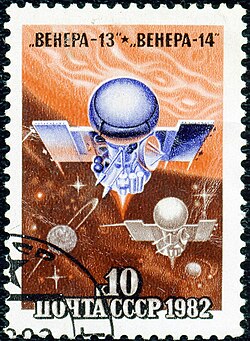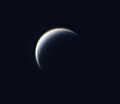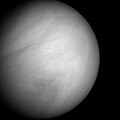 Venera 14 postage stamp | |
| Mission type | Venus flyby / lander |
|---|---|
| Operator | Soviet Academy of Sciences |
| COSPAR ID | 1981-110A 1981-110D |
| SATCAT no. | 12939 15600 |
| Mission duration | Travel: 4 months and 1 day Lander: 57 minutes |
| Spacecraft properties | |
| Spacecraft type | 4V-1 No. 761 |
| Manufacturer | NPO Lavochkin |
| Launch mass | 4,394.5 kg (9,688 lb) [1] |
| Landing mass | 760 kilograms (1,680 lb) |
| Dry mass | 1,632.71 kilograms (3,599.5 lb) |
| Dimensions | 2.7 m × 2.3 m × 5.7 m (8.9 ft × 7.5 ft × 18.7 ft) |
| Start of mission | |
| Launch date | 4 November 1981, 05:31:00 UTC [1] |
| Rocket | Proton-K/D-1 |
| Launch site | Baikonur 200/39 |
| End of mission | |
| Last contact | lander: 5 March 1982 / carrier: 9 April 1983 [2] |
| Orbital parameters | |
| Reference system | Heliocentric |
| Eccentricity | 0.17 |
| Perihelion altitude | 0.71 Astronomical units |
| Aphelion altitude | 0.99 Astronomical units |
| Inclination | 2.3 degrees |
| Period | 286 days |
| Flyby of Venus | |
| Spacecraft component | Venera 14 flight platform |
| Closest approach | March 3, 1982 |
| Distance | 26,050 km (16,190 mi) |
| Venus lander | |
| Spacecraft component | Venera 14 descent craft |
| Landing date | March 5,1982,07:00:10 UTC |
| Landing site | 13°15′S310°00′E / 13.25°S 310°E (east of Phoebe Regio) |
Venera 14 (called Venus 14 in English) was a probe in the Soviet Venera program for the exploration of Venus.
Contents
- Design
- Cruise stage
- Descent lander
- Landing
- Post encounter
- Fictional references
- Image processing
- See also
- References
- External links
Venera 14 was identical to the Venera 13 spacecraft, built to take advantage of the 1981 Venus launch opportunity. Venera 14 was launched on 4 November 1981 at 05:31:00 UTC, five days after Venera 13 launched on 30 October 1981 at 06:04:00 UTC. Both had an on-orbit dry mass of 760 kg (1,680 lb).



